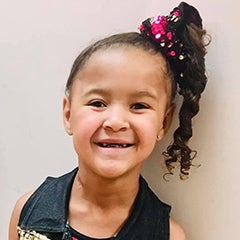Congenital Diaphragmatic Hernia
For Shablis and Dustin Harrell, watching their daughter Harley run and play every day is more than just enjoyable—it’s a true miracle. Having been born with an incredibly rare condition, she theoretically shouldn’t even be here. “She had less than a 10 percent chance of survival,” says Shablis. “She wasn’t supposed to even survive birth, but thankfully, she did.”
Harley was born with right congenital diaphragmatic hernia, a condition in which the abdominal organs are formed in the chest cavity due to the abnormal development (or as in Harley’s case, lack of development) of the diaphragm, causing the lungs to not develop properly. For Harley, it also meant she only had one lung. Right after birth, she immediately stopped breathing. “When she was born, there wasn’t a sound in the room,” Shablis says. “Instead of joy, there was crying. They kept me focused on Harley’s twin sister, Henley, who was fine, while they intubated Harley to try to keep her alive.”
Doctors eventually stabilized Harley well enough for her to be airlifted to Children’s of Alabama, where the official diagnosis was made. Doctors knew she needed to be placed on Extracorporeal Membrane Oxygenation (ECMO), a heart-lung bypass machine used to help critically ill patients like Harley get oxygen to the blood while giving the heart and lungs a chance to heal. It’s only used after all other medical treatments have failed and the odds of survival without it are less than 20 percent. But first, Harley had to undergo surgery to move her abdominal organs out of her chest cavity and create a diaphragm. “She was just three days old, so it was hard to go through with this surgery,” Shablis says. “But the surgeon came in and talked with me and explained that she had no chance to live without it. Surgery meant she had a chance to live.”
After a successful surgery, Harley was officially placed on ECMO. Children’s ECMO Center is equipped with eight machines and, in 1987, was one of the first pediatric hospitals in the Southeast to offer ECMO. Since then, Harley became one of the more than 900 children who have received the treatment—an average of 50 cases per year. Though the hurdles she’d face didn’t end. She dealt with abdominal bleeding, jaundice, the need for a feeding tube, and eventually, kidney failure requiring her to be placed on dialysis. Doctors also discovered that she had a hole in her heart, which would eventually require its own surgery. “The critical part, though, was that she was surviving,” Shablis says. “She was making it through each hurdle, though we knew we had a time limit because the amount of time she could stay on the ECMO was limited.”
Doctors informed the family that typically children can only stay on ECMO for up to six weeks. As days turned into weeks and Harley was approaching the four-week mark, her lungs were not yet showing enough improvement. Then the next miracle came: with a little extra time given on ECMO—after nearly 900 hours—chest x-rays revealed what they were all praying for: improvement in her lungs. “They were monitoring her so extremely well,” Shablis says. “They did so many x-rays that they found the improvement just in time and started prepping to take her off ECMO. It was scary—we knew she may not make it and there was nothing that could be done if the ventilator didn’t work—but we knew we had to trust the doctors again. They already saved her life once. We trusted they could do it again.”
After what seemed like days, the family got the news that ECMO was removed, she was on the ventilator, and Harley was still alive. Harley stayed on the ventilator until she was six months old. Two months later, she was able to go home for the very first time to her twin, Henley, and to meet her three older siblings. But after three weeks, she caught a common cold that sent her right back to Children’s. “The hole in her heart was causing her struggles, so the doctor had to go in surgically to repair it,” Shablis says. “After that surgery, it was amazing how much she improved.”
After a couple more months in the hospital, Harley finally went home. Now almost seven years old, the only obvious sign of Harley’s difficult medical journey are the physical scars from surgery. “She’s been through so much, but you would just never know,” Shablis says. “She’s so active and beautiful and perfect. I just can’t say enough about everyone at Children’s. They are the absolute best humans you could ever dream of. The care they had for Harley, for me, and for our family was sincere and truly life saving.”







